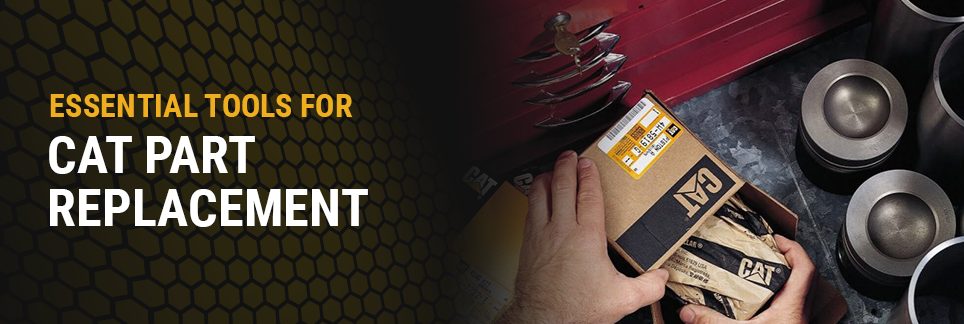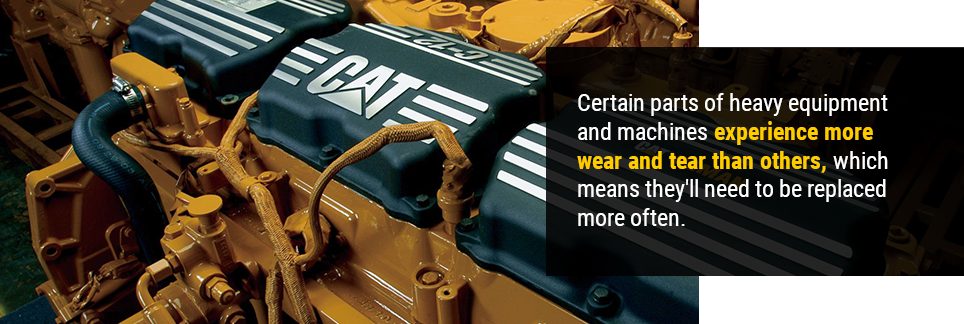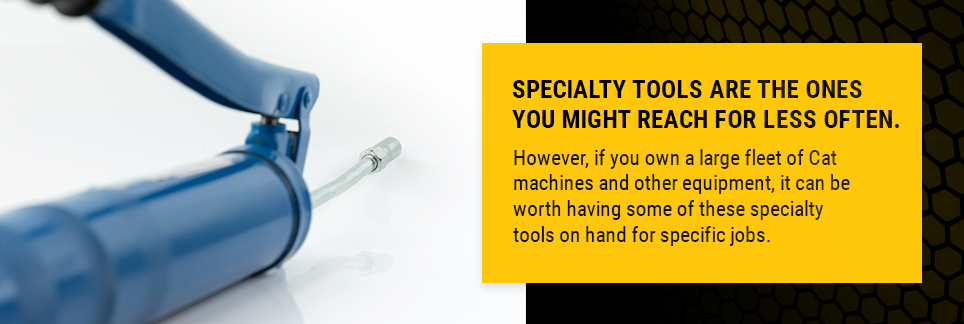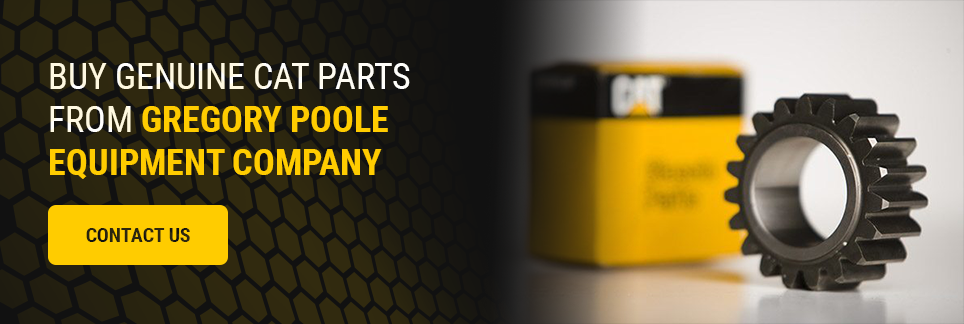
If you’re a business owner or heavy equipment operator, you know how detrimental unexpected machine downtime can be to your operations. When you work with Cat machinery, you gain the advantage of quality parts that provide long-term, reliable use. However, if your heavy equipment exhibits a sudden change in performance, it may indicate the need for a parts replacement. Having the right tools when you need them can save you time, effort and frustration.
Performing a DIY replacement yourself or with your in-house mechanics can help you get your machines back in action, but you’ll need some essential items for a successful process. Use this guide to learn about the best Cat part replacement tools you should always have on hand.
We’re using the phrase “expand your toolbox” literally here. Whether you perform your own repairs or have your team on hand to replace important parts on your Cat machines, you can streamline these processes by having the primary heavy equipment repair tools.
When you’re on a jobsite or gearing up for a complex project, the last thing you want is a machine that can’t perform to your expectations. Some heavy equipment replacements are necessary due to reduced efficiency, wear and tear, leaks, or damage. Replacing older or worn parts on your Cat equipment can help you comply with safety standards and catch problems early before they worsen.
Additionally, having the right tools to ensure a successful and efficient parts replacement can save you significant downtime in your projects. Renting a machine to do the job while yours is in repair can be a cost-effective option, but it may not always be right for your situation. If you have all the tools you could possibly need for part replacement, you can get your equipment up and running so your operators can get back on schedule.

Certain parts of heavy equipment and machines experience more wear and tear than others, which means they’ll need to be replaced more often. You may find that the following parts need more frequent repairs or replacements:
Heavy equipment tools include a wide range of electronic gadgets, diagnostic tools, safety gear and specialty tools. Here are the best tools for Cat equipment that you should have if you plan to perform a parts replacement yourself.
From the smallest nuts and bolts to heavy-duty projects, these are the essential tools for Cat repairs and replacements.
Perhaps the No. 1 tool in any toolbox is a wrench. This hand tool can be used for various heavy equipment repairs and replacement needs. You can find a wide selection of wrenches to help you easily remove the bolts on your equipment to work within your machine. Some types of wrenches you should have include:
Like wrenches, screwdrivers are everyday tools that you’ll need for almost any replacement or repair project. Different offset blade types are available, including Phillips screwdrivers and standard slotted or flathead screwdrivers. Be sure to have a few different sizes and lengths in your toolkit!
Having a traditional hammer nearby can be useful for certain stubborn parts that need to go back in place. Though a heavy-duty hammer may sometimes be necessary, you can use a dead-blow hammer to minimize surface damage if you do need to strike your equipment. You can also look for a ball-peen hammer or steel sledgehammer.
When replacing parts on your Cat equipment, you’ll likely need to grip and bend a lot of different components. Pliers are the perfect hand tools for this scenario as they’re versatile and can be used to bend wire, cut through tough materials and grip objects with more pressure. If you don’t already have some in your workshop, consider the many types of pliers that could be beneficial for your parts replacement projects:
Punches and chisels are often used together to spread apart rusty items, make holes, remove damaged bolts or drive in nails. Punches and chisels come in various shapes and sizes, so it’s a good idea to have several on hand for your DIY projects. You can find hollow and solid punches to help you puncture a surface with a hammer. Chisels are ideal when working with metal components as they can effectively cut or shape metal to your needs. Types of chisels include:
If you need to access the tires or undercarriage of your machine, a hydraulic jack is one of the top tools for Cat parts. This tool helps keep the heavy equipment off the ground. Like working on a car, these mechanical jacks can lift excavators, backhoes and other heavy-duty machines so you can replace tires and brake pads. A jack is an absolute necessity for preventing injuries and damage to your machines when accessing parts for upkeep.
A ratchet is a helpful hand tool you can use to tighten or loosen bolts and nuts on your Cat machinery. This hand tool features a locking mechanism that allows you to tighten in incremental movements for a wide range of replacement needs. Ratchets are often used when working with tie-down straps, caulking guns, grease guns, slacklines, cable ties and jacks. Like many hand tools, ratchets come in standard drive sizes of ¼-, 3/8- and ½-inch.
Having a set of picks in your toolkit is great for prying apart small items with ease. You can use a heavy-duty pick set for your Cat equipment to remove or position wires, clean out clogged nozzles, work in tight spaces or remove seals.
Similar to a ratchet, a socket or socket wrench is used to turn or remove nuts and bolts. Unlike a ratchet, however, socket wrenches often require two hands to use — but they have fewer moving parts. While ratchets have fixed square drive sizes, socket wrenches are available in interchangeable sockets, so you can use them for a wider range of nuts and bolt sizes on your equipment. Sockets are also ideal for use in confined spaces and can be used with a ratchet for certain tasks.
Not quite sure what needs to be repaired or replaced? Though visible damage or signs of wear can be your first clue, you can use some diagnostic tools to help you locate specific system issues that you may not be able to see.
If you own any Cat machine equipped with tires, you need a tire pressure gauge. This diagnostic tool measures the amount of air in your equipment’s tires, helping you determine if they’re under-inflated. A tire pressure gauge can also help you identify if improper tire pressure has been contributing to increased wear and tear or decreased gas mileage in your machines.
A scan tool is ideal for identifying short circuits and checking electrical components in your heavy equipment. You can also use a code reader that provides generic diagnostic codes to help you determine if a part needs to be replaced.
A digital multimeter is often used in the automotive industry to test various electronics and circuits. You can use a digital multimeter, or a multi-tester, in your workshop to measure amps, volts and resistance. This tool is commonly used to test batteries in machines and streamline troubleshooting.
Similar to a physician’s stethoscope, mechanics can use this tool to identify issues in the internal components of heavy equipment. A mechanic’s stethoscope can amplify sounds to help you pinpoint potential damage in gears, pumps, valves and vents.
In addition to the above diagnostic tools, you can also rely on a range of meters, gauges and software programs to determine equipment performance and replacement needs.

Specialty tools are the ones you might reach for less often. However, if you own a large fleet of Cat machines and other equipment, it can be worth having some of these specialty tools on hand for specific jobs.
As the name suggests, an inspection mirror helps heavy equipment mechanics see in confined, hard-to-reach spaces. Some inspection mirrors have lights to illuminate dark areas, such as the undercarriage. This specialty tool may not be used daily, but it will certainly make the job easier when trying to see into difficult or dangerous areas on your heavy equipment.
Lubrication is a critical part of maintaining your heavy-duty equipment. Without proper lubrication, your Cat machines can experience much more wear and tear. A grease gun, or greaser, is a specialty tool designed to make lubrication for heavy-duty equipment parts a breeze. It allows you to apply lubricant only where it’s needed to prevent waste and keep other areas clean. There are several types of grease guns:
If you’ve run into a broken or damaged screw or bolt when trying to replace a part on your Cat machine, you’ve likely spent more time than necessary trying to dig it out. An easy-out tool is a type of screw extractor that allows you to get a good grip on a broken or seized screw and remove it from your equipment.
A hose press or hose crimping machine is a specialty mechanical device that aligns hoses or tubing with metal fittings. This tool clamps the metal fittings onto the end of the hose or tube, usually to help hydraulic fluid pass into a machine.
As simple as it sounds, having a pick up magnet in your workshop can save you a lot of frustration. If you’ve ever dropped a small piece of hardware into a confined space, you know how difficult it can be to get it back! Pickup magnets are simple tools that can help you retrieve metal pieces that have fallen into hidden or tight spaces.
Feel like you’re missing something? Check out this list of miscellaneous Cat part installation tools that may be worth keeping in your maintenance area. Here’s a tip — if you have to borrow or rent one of these tools more than three times, it’s probably worth owning!

There’s no using heavy equipment and tools without safety protocols. Now’s a good time to check that your mechanics and operators have access to the following items in your workshop to prevent injuries and damage.

Whether you’re replacing parts on your fleet yourself or having your mechanic do it for you, it’s critical to work with high-quality parts. When you purchase Cat parts from Gregory Poole, you can feel confident that you’re receiving industry-leading parts to help get your machines back up and running.
At Gregory Poole, we offer remanufactured, new and used performance and general duty parts. We maintain a diverse selection of parts for all your specialized and heavy equipment needs. If you need a replacement part for your Cat machine, contact us at Gregory Poole to place an order, or find a location near you!